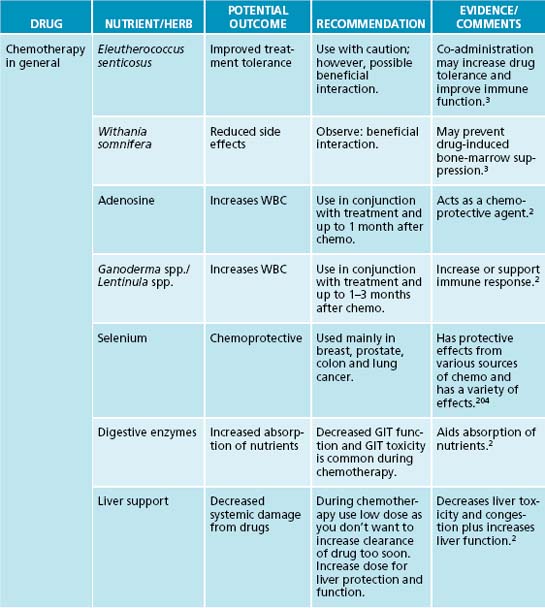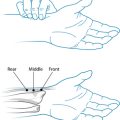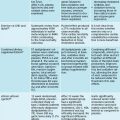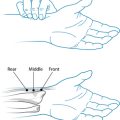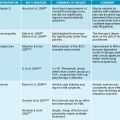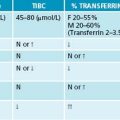Appendix 2 Chemotherapy drugs and concurrent complementary therapy
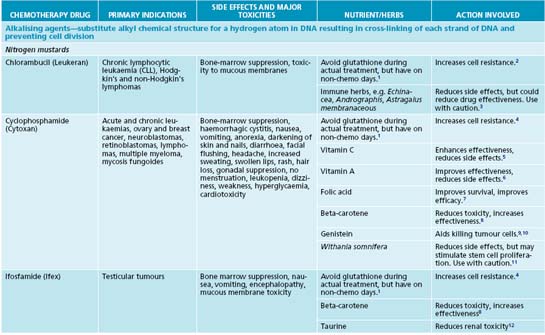
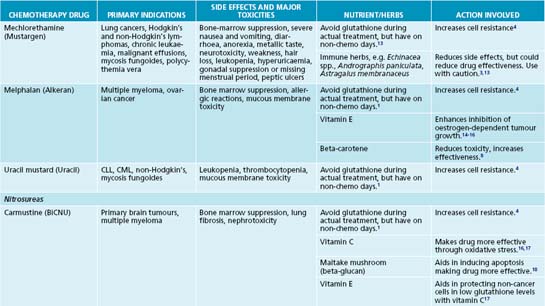
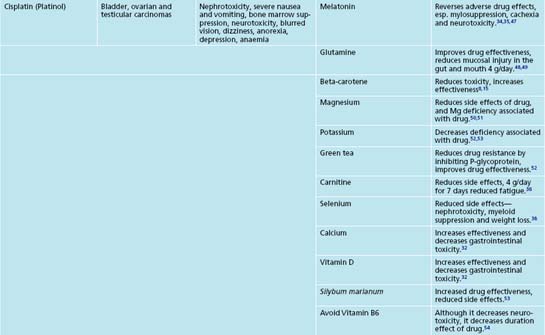
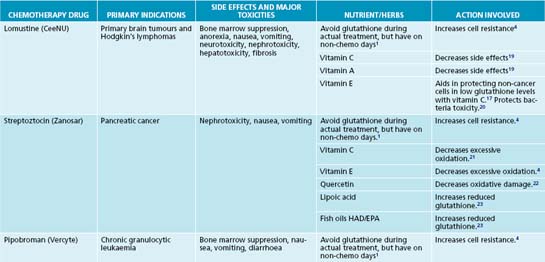
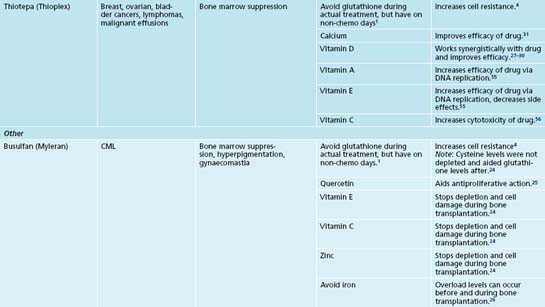
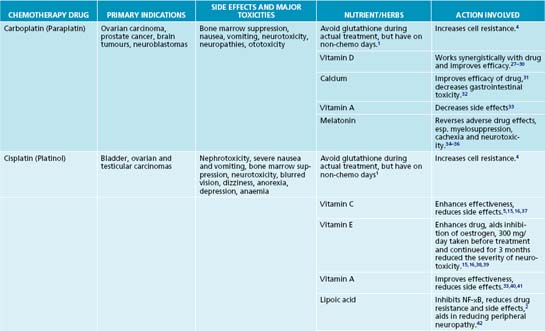
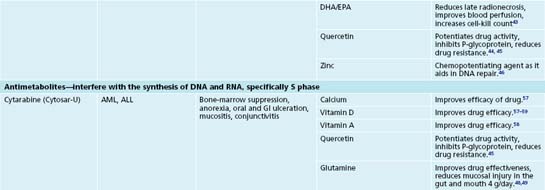
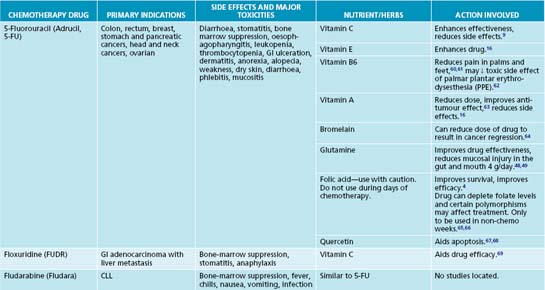
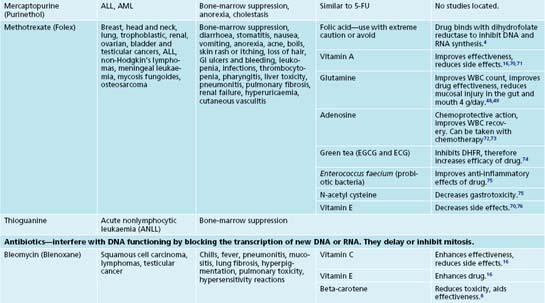
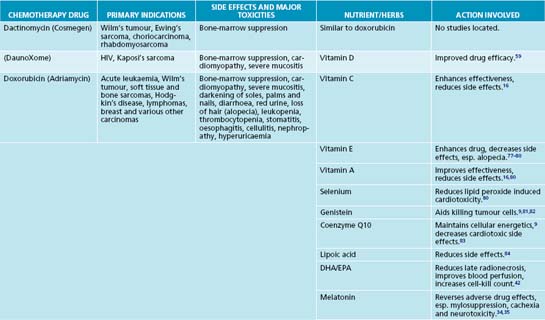

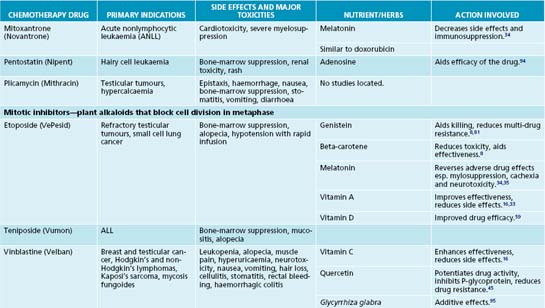
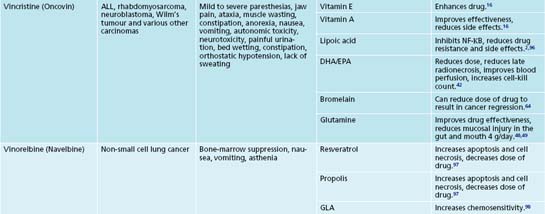
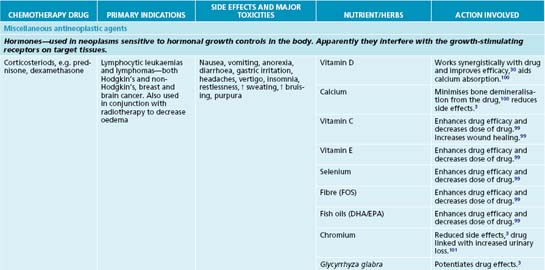
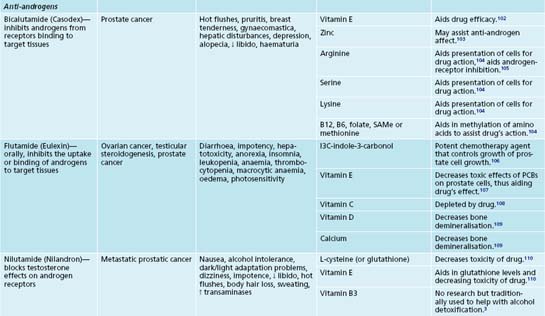
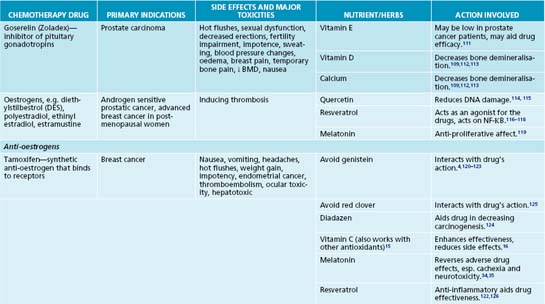
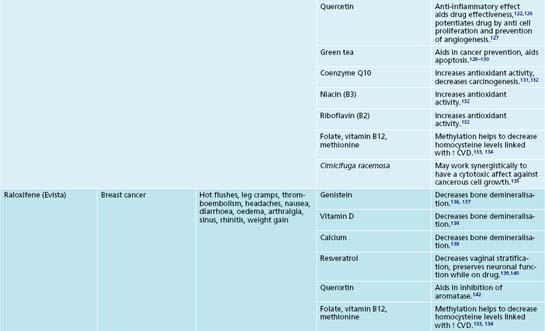
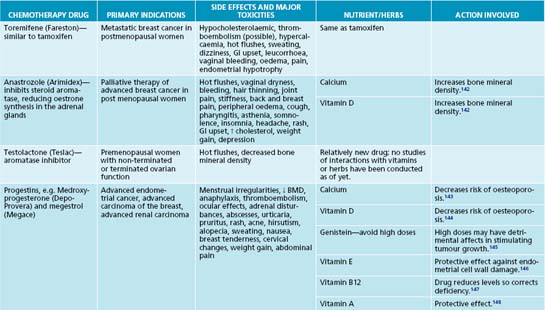

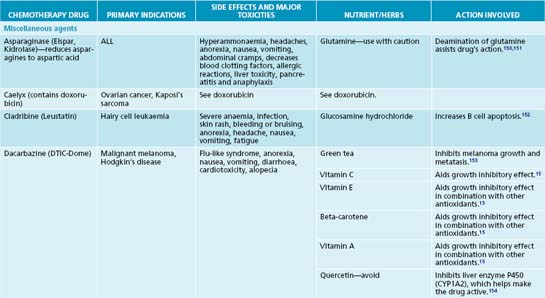
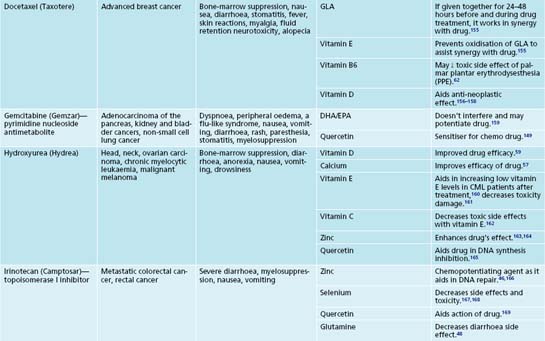
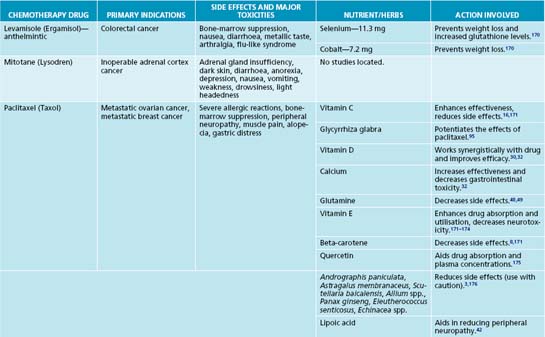
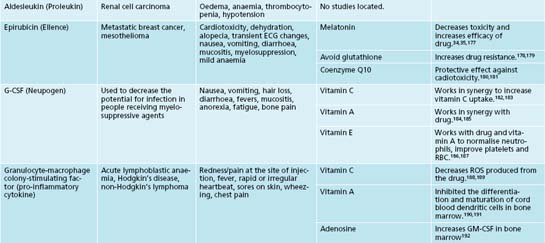

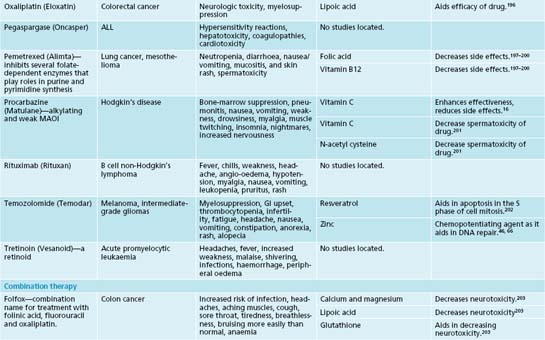
1. Frischer H., Ahmad T. Severe generalized glutathione reductase deficiency after antitumour chemotherapy with BCNU″[1,3-bis(chloroethyl)-1-nitrosourea]. J Lab Clin Med. 1977;89(5):1080-1091.
2. Osiecki H. Cancer: a nutritional/biochemical approach, 2nd edn. Brisbane: BioConcepts Publishing; 2003.
3. Braun L., Cohen M. Herbs and natural supplements, an evidence-based guide, 3rd edn. Sydney: Elsevier; 2005.
4. Salerno E. Pharmacology for health professionals. St Louis: Mosby; 1999.
5. Kurbacher C.M., et al. Ascorbic acid (vitamin C) improves the antineoplastic activity of doxorubicin, cisplatin, and paclitaxel in human breast carcinoma cells in vitro. Cancer Lett. 1996;103(2):183-189.
6. Tsutani H., et al. Pharmacological studies of retinol palmitate and its clinical effect in patients with acute non-lymphocytic leukemia. Leuk Res. 1991;15(6):463-471.
7. Branda R.F., et al. Nutritional folate status influences the efficacy and toxicity of chemotherapy in rats. Blood. 1998;92(7):2471-2476.
8. Teicher B.A., et al. In vivo modulation of several anticancer agents by beta-carotene. Cancer Chemother Pharmacol. 1994;34(3):235-241.
9. Conklin A. Dietary antioxidants during cancer chemotherapy: impact on chemotherapeutic effectiveness and development of side effects. Nutr Cancer. 2000;37(1):1-18.
10. Wietrzyk J., et al. Antiangiogenic and antitumour effects in vivo of genistein applied alone or combined with cyclophosphamide. Anticancer Res. 2001;21(6A):3893-3896.
11 Davis L., Kuttan G. Effect of Withania somnifera on cyclophosphamide-induced urotoxicity. Cancer Lett. 2000;148(1):9-17.
12. Badary O.A. Taurine attenuates Fanconi syndrome induced by ifosimide without compromising its anti-tumour activity. Oncol Res. 1998;10(7):355-360.
13. Mills S., Bone K. The essential guide to herbal safety. St Louis: Churchill Livingstone; 2005.
14. Heisler T., et al. Peptide YY and vitamin E inhibit hormone-sensitive and -insensitive breast cancer cells. J Surg Res. 2000;91(1):9-14.
15. Prasad K.N., et al. Modification of the effect of tamoxifen, cis-platin, DTIC, and interferon-alpha 2b on human melanoma cells in culture by a mixture of vitamins. Nutr Cancer. 1994;22(3):233-245.
16. Prasad K.N., et al. High doses of multiple antioxidant vitamins: essential ingredients in improving the efficacy of standard cancer therapy. J Am Coll Nutr. 1999;18(1):13-25.
17. Nakagawa Y., et al. Relationship between ascorbic acid and alpha-tocopherol during diquat-induced redox cycling in isolated rat hepatocytes. Biochem Pharmacol. 1991;25:42(4):883-888.
18. Fullerton S.A., et al. Induction of apoptosis in human prostatic cancer cells with beta-glucan (maitake mushroom rythrocytese). Mol Urol. 2000;4(1):7-13.
19. Georgian L., et al. The protective effect of vitamin A and vitamin C on the chromosome-damaging activity of CCNU. Morphol Embryol (Bucur). 1986;32(4):241-245.
20. Gadjeva V., et al. Spin labeled antioxidants protect bacteria against the toxicity of alkylating antitumor drug CCNU. Toxicol Lett. 2003;144(3):289-294.
21. Blasiak J., et al. Genotoxicity of streptozotocin in normal and cancer cells and its modulation by free radical scavengers. Cell Biol Toxicol. 2004;20(2):83-96.
22. Mahesh T., Menon V.P. Quercetin allievates oxidative stress in streptozotocin-induced diabetic rats. Phytother Res. 2004;18(2):123-127.
23. Yilmaz O., et al. Effects of alpha lipoic acid, ascorbic acid-6-palmitate, and fish oil on the gluthione, malonaldehyde, and fatty acid levels in rythrocytes of streptozotocin induced diabetic male rats. J Cell Biochem. 2002;86(3):530-539.
24. Jonas C.R., et al. Plasma antioxidant status after high dose chemotherapy: a randomised trial of parenteral nutrition in bone marrow transplantation patients. Am J Clin Nutr. 2000;72(1):181-189.
25. Hoffman R., et al. Enhanced anti-proliferative action of busulphan by quercetin on the human leukaemia cell line K562. Br J Cancer. 1989;59(3):347-348.
26. Durken M., et al. Deteriorating free radical-trapping capacity and antioxidant status in plasma during bone marrow transplantation. Bone Marrow Transplant. 1995;15(5):757-762.
27. Beer T.M., et al. High-dose calcitriol and carboplatin in metastatic androgen-independent prostate cancer. Am J Clin Oncol. 2004;27(5):535-541.
28. Wigington D.P., et al. Combination study of 1,24(S)-dihydroxyvitamin D2 and chemotherapeutic agents on human breast and prostate cancer cell lines. Anticancer Res. 2004;24(5A):2905-2912.
29. Trump D.L., et al. Anti-tumor activity of calcitriol: pre-clinical and clinical studies. J Steroid Biochem Mol Biol. 2004;89–90(1–5):519-526.
30. Johnson C.S., et al. Vitamin D-related therapies in prostate cancer. Cancer Metastasis Rev. 2002;21(2):147-158.
31. Saunders D.E., et al. Additive inhibition of RL95-2 endometrial carcinoma cell growth by carboplatin and 1,25 dihydroxyvitamin D3. Gynecol Oncol. 1993;51(2):155-159.
32. Meara D.J., et al. Role of calcium in modulation of toxicities due to cisplatin and its analogs: a histochemical approach. Anticancer Drugs. 1997;8(10):988-999.
33. Lovat P.E., et al. Synergistic induction of apoptosis of neuroblastoma by fenretinide or CD437 in combination with chemotherapeutic drugs. Int J Cancer. 2000;88(6):977-985.
34. Lissoni P., et al. Treatment of cancer chemotherapy-induced toxicity with the pineal hormone melatonin. Support Care Cancer. 1997;5(2):126-129.
35. Jung B., Ahmad N. Melatonin in cancer management: progress and promise. Cancer Res. 2006;66(20):9789-9793.
36. Ghielmini M., et al. Double-blind randomized study on the myeloprotective effect of melatonin in combination with carboplatin and etoposide in advanced lung cancer. Br J Cancer. 1999;80(7):1058-1061.
37. Antunes L.M., et al. Protective effects of vitamin C against cisplatin-induced nephrotoxicity and lipid peroxidation in adult rats: a dose dependent study. Pharmacol Res. 2000;41(4):405-411.
38. Ali B.H., Al Moundhri M.S. Agents ameliorating or augmenting the nephrotoxicity of cisplatin and other platinum compounds: some recent research. Food Chem Toxicol. 2006;44(8):1173-1183.
39. Pace A., et al. Neuroprotective effect of vitamin E supplementation in patients treated with cisplatin chemotherapy. J Clin Oncol. 2003;21(5):927-931.
40. Weisman R.A., et al. Phase I trial of retinoic acid and cis-platinum for advanced squamous cell cancer of the head and neck based on experimental evidence of drug synergism. Otolaryngol Head Neck Surg. 1998;118(5):597-602.
41. Kalemkerian G.P., et al. A phase II study of all-trans-retinoic acid plus cisplatin and etoposide in patients with extensive stage small cell lung carcinoma: an Eastern Cooperative Oncology Group Study. Cancer. 1998;83(6):1102-1108.
42. Melli G., et al. Alpha-lipoic acid prevents mitochondrial damage and neurotoxicity in experimental chemotherapy neuropathy. Exp Neurol. 2008;214(2):276-284.
43. Bougnoux P. n-3 polyunsaturated fatty acids and cancer. Curr Opin Clin Nutr Metab Care. 1999;2(2):121-126.
44. Jakubowicz-Gil J., et al. The effect of quercetin on pro-apoptotic activity of cisplatin in HeLa cells. Biochem Pharmacol. 2005;69(9):1343-1350.
45. Francescato H.D., et al. Protective effect of quercetin on the evolution of cisplatin-induced acute tubular necrosis. Kidney Blood Press Res. 2004;27(3):148-158.
46. Sliwinski T., et al. Zinc salts differentially modulate DNA damage in normal and cancer cells. Cell Biol Int. 2009;33(4):542-547.
47. Lissoni P., et al. A randomized study of chemotherapy with cisplatin plus etoposide versus chemo-endocrine therapy with cisplatin, etoposide and the pineal hormone melatonin as a first-line treatment of advanced non-small cell lung cancer in patients in a poor clinical state. J Pineal Res. 1999;23(1):15-19.
48. Savarese D.M., et al. Prevention of chemotherapy and radiation toxicity with glutamine. Cancer Treat Rev. 2003;29(6):501-513.
49. Anderson P.M., et al. Oral glutamine reduces the duration and severity of stomatitis after cancer chemotherapy. Cancer. 1998;83:1433-1439.
50. Buckley J.E., et al. Hypomagnesemia after cisplatin combination therapy. Arch Intern Med. 1982;144:2347.
51. Van de Loosdrecht A.A., et al. Seizures in a patient with disseminated testicular cancer due to cisplatin-induced hypomagnesaemia. Acta Oncol. 2000;39:239-240.
52. Sadzuka Y., et al. Modulation of cancer chemotherapy by green tea. Clin Cancer Res. 1998;4(1):153-156.
53. Sonnenbichler J., et al. Stimulatory effects of silibinin and silicristin from the milk thistle Silybum marianum on kidney cells. J Pharmacol Exp Ther. 1999;290(3):1375-1383.
54. Slavik M., et al. Changes in serum copper and zinc during treatment with anticancer drugs interfering with pyridoxal phosphate. Adv Exp Med Biol. 1989;258:235-242.
55. Radu L., et al. The combined action of thiotepa and lomustine cytostatics, of estradiol hormone and of vitamins E and A on Walker tumor chromatin structure. Rom J Endocrinol. 1993;31(3–4):149-153.
56. Lialiaris T., et al. Enhancement and attenuation of cytogenetic damage by vitamin C in cultured human lymphocytes exposed to thiotepa or L-ethionine. Cytogenet Cell Genet. 1987;44(4):209-214.
57. Studzinski G.P., et al. Potentiation by 1-alpha, 25 dihdroxyvitamin D3 of cytotoxicity to HL-60 cells produced by cytarabine and hydroxyurea. J Natl Cancer Inst. 1986;76(4):641-648.
58. Kim C.H. Increased expression of N-acetylglucosaminyltransferase-V in human hepatoma cells by retinoic acid and 1alpha,25-dihydroxyvitamin D3. Int J Biochem Cell Biol. 2004;36(11):2307-2319.
59. Makishima M., et al. Growth inhibition and differentiation induction in human monoblastic leukaemia cells by 1alpha-hydroxyvitamin D derivatives and their enhancement by combination with hydroxyurea. Br J Cancer. 1998;77(1):33-39.
60. Vukelja S.J., et al. Pyridoxine for the palmar-plantar erythrodysesthesia syndrome. Ann Intern Med. 1989;111(8):688-689.
61. Fabian C.J., et al. Pyridoxine therapy for palmar-plantar erythrodysesthesia associated with continuous 5-fluorouracil infusion. Invest New Drugs. 1990;8(1):57-63.
62. Nagore E., et al. Antineoplastic therapy-induced palmar plantar erythrodysesthesia (‘hand-foot’) syndrome. Incidence, recognition and management. Am J Clin Dermatol. 2000;1(4):225-234.
63. Nakashima T., et al. Phase 1 study of concurrent radiotherapy with TS-1 and vitamin A (TAR therapy) for head and neck cancer. Gan To Kagaku Tyoho. 2005;32(6):803-807.
64. Lotz-Winter H. On the pharmacology of bromelain: an update with special regard to animal studies on dose-dependent effects. Planta Med. 1990;56(3):249-253.
65. Toffoli G., Cecchin E. Uridine diphosphoglucuronosyl transferase and methylenetetrahydrofolate reductase polymorphisms as genomic predictors of toxicity and response to irinotecan-, antifolate- and fluoropyrimidine-based chemotherapy. [Review] J Chemother. 2004;16(Suppl 4):31-35.
66. Etienne M.C., et al. Thymidylate synthase and methylenetetrahydrofolate reductase gene polymorphisms: relationships with 5-fluorouracil sensitivity. Br J Cancer. 2004;90(2):526-534.
67. Zhong X., et al. [Effects of quercetin on the proliferation and apoptosis in transplantation tumor of breast cancer in nude mice]. Sichuan Da Xue Xue Bao Yi Xue Ban. 2003;34(3):439-442.
68. Koide T., et al. Influence of flavonoids on cell cycle phase as analyzed by flow-cytometry. Cancer Biother Radiopharm. 1997;12(2):111-115.
69. Yuan H., Zhang Z. Some factors affecting sister-chromatid differentiation (SCD) and sister-chromatid exchange (SCE) in Hordeum vulgare. Mutat Res. 1992;272(2):125-131.
70. Pyrhonen S., et al. Randomised comparison of fluorouracil, epidoxorubicin and methotrexate (FEMTX) plus supportive care with supportive care alone in patients with non-resectable gastric cancer. Br J Cancer. 1995;71(3):587-591.
71. Nagai Y., et al. Vitamin A, a useful biochemical modulator capable of preventing methotrexate damage during methotrexate treatment. Pharmacol Toxicol. 1993;73:69-74.
72. Fishman P., et al. Adenosine acts as a chemoprotective agent by stimulating G-CSF production: a role for A1 and A3 adenosine receptors. J Cell Physiol. 2000;183(3):393-398.
73. Ohana G., et al. Differential effect of adenosine on tumour and normal cell growth: focus on the A3 adenosine receptor. J Cell Physiol. 2001;186(1):19-23.
74. Navarro-Peran E., et al. Kinetics of the inhibition of bovine liver dihydrofolate reductase by tea catechins: origin of slow-binding inhibition and pH studies. Biochemistry. 2005;44(20):7512-7525.
75. Rovensky J., et al. The effects of Enterococcus faecium and selenium on methotrexate treatment in rat adjuvant-induced arthritis. Clin Dev Immunol. 2004;11(3–4):267-273.
76. Mivazono Y., et al. Oxidative stress contributes to methotrexate-induced small intestinal toxicity in rats. Scand J Gastroenterol. 2004;39(11):1119-1127.
77. Perez J.E., et al. High-dose alpha-tocopherol as a preventive of doxorubicin-induced alopecia. Cancer Treat Rep. 1986;70(10):1213-1214.
78. Shinozawa S., et al. Effect of high dose alpha-tocopherol and alpha-tocopherol pretreatment on adriamycin (doxocurbicin) induced toxicity and tissue distribution. Physiol Chem Med NMR. 1988;20(4):329-335.
79. Ripoll E.A., et al. Vitamin E enhances the chemotherapeutic effects of adriamycin on human prostatic carcinoma cells in vitro. J Urol. 1986;136(2):529-531.
80. Quiles J.L., et al. Antioxidant nutrients and adriamycin toxicity. Toxicology. 2002;180(1):79-95.
81. Versantvoort C.H., et al. Genistein modulates the decreased drug accumulation in non-P-glycoprotein mediated multidrug resistant tumour cells. Br J Cancer. 1993;68(5):939-946.
82. Monti E., Sinha B.K. Antiproliferative effect of genistein and adriamycin against estrogen-dependent and -independent human breast cell carcinoma lines. Anticancer Res. 1994;14(3):1221-1223.
83. Conklin K.A. Coenzyme Q10 for prevention of anthracycline-induced cardiotoxicity. Integr Cancer Ther. 2005;4(2):110-130.
84. Dovinova I., et al. Combined effect of lipoic acid and doxorubicin in murine leukaemia. Neoplasma. 1999;46(4):237-241.
85. Mijares A., Lopez J.R. L-carnitine prevents increase in diastolic [Ca2+] induced by doxocurbicin in cardiac cells. Eur J Pharmacol. 2001;425(2):117-120.
86. Waldner R., et al. Effects of doxocuribicin-containing chemotherapy and a combination with L-carnitine on oxidative metabolism in patients with non-Hodgkin lymphoma. J Cancer Res Clin Oncol. 2006;132(2):121-128.
87. Yeh Y.C., et al. A standardized extract of Ginkgo biloba suppresses doxorubicin-induced oxidative stress and p53-mediated mitochondrial apoptosis in rat testes. Br J Pharmacol. 2009;156(1):48-61.
88. Hu Q., et al. Antimutagenicity of selenium-enriched rice on mice exposure to cyclophosphamide and mitomycin C. Cancer Lett. 2005;220(1):29-35.
89. Fuga L., et al. Vitamin B2 (riboflavin) and a mixture of vitamin B2 and C affects MMC efficiency in aerated media under irradiation. Anticancer Res. 2004;24(6):4031-4034.
90. Kammerer C., Getoff N. Synergistic effect of dehydroascorbic acid and mixtures with vitamin E and beta-carotene on mitomycin C efficiency under irradiation in vitro. In Vivo. 2004;18(6):795-798.
91. Krishnaia A.P., Sharma N.K..Ascorbic acid potentiates mitomycin C-induced micronuclei and sister chromatid exchanges in human peripheral blood lymphocytes in vitro. Teratog Carcinog Mutagen. 2003;(Suppl 1):99-112.
92. Undeger U., et al. The modulating effects of quercetin and rutin on the mitomycin C induced DNA damage. Toxicol Lett. 2004;151(1):143-149.
93. Kurita T., et al. A dosage design of mitomycin C tablets containing finely powdered green tea. Int J Pharm. 2004;275(1–2):279-283.
94. Niitsu N., Homma Y. Adenosine analogs as possible differentiation-inducing agents against acute myeloid leukemia. [Review] Leuk Lymphoma. 1999;34(3–4):261-271.
95. Rafi M.M., et al. Modulation of bcl-2 and cytotoxicity by licochalcone-A, a novel estrogenic flavonoid. Anticancer Res. 2000;20(4):2653-2658.
96. Berger M., et al. Effect of thiocitic acid (alpha-lipoic acid) on the chemotherapeutic efficacy of cyclophosphamide and vincristine sulphate. Arzneimittelforschung. 1983;33(9):1286-1288.
97. Scifo C., et al. Resveratrol and propolis as necrosis or apoptosis inducers in human prostate carcinoma cells. Oncol Res. 2004;14(9):415-426.
98. Menendez J.A., et al. Synergistic interaction between vinorelbine and gamma-linolenic acid in breast cancer cells. Breast Cancer Res Treat. 2002;72(3):203-219.
99. Seidner D.L., et al. An oral supplement enriched with fish oil, soluble fiber, and antioxidants for corticosteroid sparing in ulcerative colitis: a randomized, controlled trial. Clin Gastroenterol Hepatol. 2005;3(4):358-369.
100. Nesbitt L.T. Minimizing complications from systemic glucocorticosteroid use. Dermatol Clin. 1995;13(4):925-939.
101. Ravina A., et al. Reversal of corticosteroid-induced diabetes mellitus with supplemental chromium. Diabet Med. 1999;16(2):164-167.
102. Thompson T.A., Wilding G. Androgen antagonist activity by the antioxidant moiety of vitamin E, 2,2,5,7,8-pentamethyl-6-chromanol in human prostate carcinoma cells. Mol Cancer Ther. 2003;2(8):797-803.
103. Jiang F., Wang Z. Identification and characterization of PLZF as a prostatic androgen-responsive gene. Prostate. 2004;59(4):426-435.
104. Kang Z., et al. Coregulator recruitment and histone modifications in transcriptional regulation by the androgen receptor. Mol Endocrinol. 2004;18(11):2633-2648.
105. Juniewicz P.E., et al. Effects of androgen and antiandrogen treatment on canine prostatic arginine esterase. Prostate. 1990;17(2):101-111.
106. Zhang J., et al. Indole-3-carbinol induces a G1 cell cycle arrest and inhibits prostate-specific antigen production in human LNCaP prostate carcinoma cells. Cancer. 2003;98(11):2511-2520.
107. Mi Y., Zhang C. Toxic and hormonal effects of polychlorinated biphenyls on cultured testicular germ cells of embryonic chickens. Toxicol Lett. 2005;155(2):297-305.
108. Mathur P.P., Chattopadhyay S. Involvement of lysosomal enzymes in flutamide-induced stimulation of rat testis. Andrologia. 1982;14(2):171-176.
109. Diamond T., et al. The effect of combined androgen blockade on bone turnover and bone mineral densities in men treated for prostate carcinoma: longitudinal evaluation and response to intermittent cyclic etidronate therapy. Cancer. 1998;83(8):1561-1566.
110. Fau D., et al. Mechanism for the hepatotoxicity of the antiandrogen, nilutamide. Evidence suggesting that redox cycling of this nitroaromatic drug leads to oxidative stress in isolated hepatocytes. J Pharmacol Exp Ther. 1992;263(1):69-77.
111. Iynem A.H., et al. The effect of prostate cancer and antiandrogenic therapy on lipid peroxidation and antioxidant systems. Int Urol Nephrol. 2004;36(1):57-62.
112. Diamond T.H., et al. Osteoporosis and spinal fractures in men with prostate cancer: risk factors and effects of androgen deprivation therapy. J Urol. 2004;172(2):529-532.
113. Hatano T., et al. Incidence of bone fracture in patients receiving luteinizing hormone-releasing hormone agonists for prostate cancer. BJU Int. 2000;86(4):449-452.
114. Cemeli E., et al. Modulation by flavonoids of DNA damage induced by estrogen-like compounds. Environ Mol Mutagen. 2004;44(5):420-426.
115. Kitson T.M., et al. Interaction of sheep liver cytosolic aldehyde dehydrogenase with quercetin, resveratrol and diethylstilbestrol. Chem Biol Interact. 2001;130–132(1–3):57-69.
116. Gehm B.D., et al. Estrogenic effects of resveratrol in breast cancer cells expressing mutant and wild-type estrogen receptors: role of AF-1 and AF-2. J Steroid Biochem Mol Biol. 2004;88(3):223-234.
117. Morris G.Z., et al. Resveratrol induces apoptosis in LNCaP cells and requires hydroxyl groups to decrease viability in LNCaP and DU 145 cells. Prostate. 2002;52(4):319-329.
118. Cho D.I., et al. Effects of resveratrol-related hydroxystilbenes on the nitric oxide production in macrophage cells: structural requirements and mechanism of action. Life Sci. 2002;71(17):2071-2082.
119. Karasek M., et al. Melatonin inhibits growth of diethylstilbestrol-induced prolactin-secreting pituitary tumor in vitro: possible involvement of nuclear RZR/ROR receptors. J Pineal Res. 2003;34(4):294-296.
120. Jones J.L., et al. Genistein inhibits tamoxifen effects on cell proliferation and cell cycle arrest in T47D breast cancer cells. Am Surg. 2002;68(6):575-577. discussion 577–578
121. Ju Y.H., et al. Dietary genistein negates the inhibitory effect of tamoxifen on growth of estrogen-dependent human breast cancer (MCF-7) cells implanted in athymic mice. Cancer Res. 2002;62(9):2474-2477.
122. Ravindranath M.H., et al. Anticancer therapeutic potential of soy isoflavone, genistein. [Review] Adv Exp Med Biol. 2004;546:121-165.
123. Liu B., et al. Low-dose dietary phytoestrogen abrogates tamoxifen-associated mammary tumour prevention. Cancer Res. 2005;65(3):879-886.
124. Constantinou A.L., et al. The soy isoflavone daidzein improves the capacity of tamoxifen to prevent mammary tumours. Eur J Cancer. 2005;41(4):647-654.
125. Herbal Medicine Research and Education Centre. Herbs used in menopause. Complementary Medicine. 2005;4(4):51.
126. Donnelly L.E., et al. Anti-inflammatory effects of resveratrol in lung epithelial cells: molecular mechanisms. Am J Physiol Lung Cell Mol Physiol. 2004;287(4):L774-L783.
127. Ma Z.S., et al. Reduction of CWR22 prostate tumor xenograft growth by combined tamoxifen-quercetin treatment is associated with inhibition of angiogenesis and cellular proliferation. Int J Oncol. 2004;24(5):1297-1304.
128. Fujiki H., et al. Cancer prevention with green tea and monitoring by a new biomarker, hnRNP B1. [Review] Mutat Res. 2001;480–481:299-304.
129. Suganuma M., et al. Mechanisms of cancer prevention by tea polyphenols based on inhibition of TNF-alpha expression. Biofactors. 2000;13(1–4):67-72.
130. Suganuma M., et al. Combination cancer chemoprevention with green tea extract and sulindac shown in intestinal tumor formation in Min mice. J Cancer Res Clin Oncol. 2001;127(1):69-72.
131. Perumal S.S., et al. Combined efficacy of tamoxifen and coenzyme Q10 on the status of lipid peroxidation and antioxidants in DMBA induced breast cancer. Mol Cell Biochem. 2005;273(1–2):151-160.
132. Perumal S.S., et al. Augmented efficacy of tamoxifen in rat breast tumorigenesis when gavaged along with riboflavin, niacin, and CoQ10: effects on lipid peroxidation and antioxidants in mitochondria. Chem Biol Interact. 2005;152(1):49-58.
133. De Leo V., et al. Menopause, the cardiovascular risk factor homocysteine, and the effects of treatment. [Review] Treat Endocrinol. 2004;3(6):393-400.
134. Palomba S., et al. Lipid, glucose and homocysteine metabolism in women treated with a GnRH agonist with or without raloxifene. Hum Reprod. 2004;19(2):415-421.
135. Al Akoum M., et al. Synergistic cytotoxic effect of tamoxifen and black cohosh on MCF-7 and MDA-MB-231 human breast cancer cells: an in vitro study. Can J Physiol Pharmacol. 2007;85(11):1153-1159.
136. Rickard D.J., et al. Phytoestrogen genistein acts as an estrogen agonist on human osteoblastic cells through estrogen receptors alpha and beta. J Cell Biochem. 2003;89(3):633-646.
137. Rliwinski L., et al. Differential effects of genistein, estradiol and raloxifene on rat osteoclasts in vitro. Pharmacol Rep. 2005;57(3):352-359.
138. Antoniucci D.M., et al. Vitamin D insufficiency does not affect bone mineral density response to raloxifene. J Clin Endocrinol Metab. 2005;90(8):4566-4572.
139. Hascalik S., et al. Effects of resveratrol, raloxifene, tibolone and conjugated equine estrogen on vaginal squamous cell maturation of ovariectomized rats. Gynecol Obstet Invest. 2005;60(4):186-191.
140. Celik O., et al. Magnetic resonance spectroscopic comparison of the effects of resveratrol (3,4′,5-trihydroxy stilbene) to conjugated equine estrogen, tibolone and raloxifene on ovariectomized rat brains. Eur J Obstet Gynecol Reprod Biol. 2005;120(1):73-79.
141. Fiorelli G., et al. Estrogen synthesis in human colon cancer epithelial cells. J Steroid Biochem Mol Biol. 1999;71(5–6):223-230.
142. Paterson A.H. Evaluating bone mass and bone quality in patients with breast cancer. Clin Breast Cancer. 2005;5(Suppl 2):S41-S45.
143. Lindsay R., et al. Bone response to treatment with lower doses of conjugated estrogens with and without medroxyprogesterone acetate in early postmenopausal women. Osteoporos Int. 2005;16(4):372-379.
144. Brodowska A. [The influence of hormonal replacement therapy on bone density in postmenopausal women depending on polymorphism of vitamin D receptor (VDR) and estrogen receptor (ER) genes]. Ann Acad Med Stetin. 2003;49:111-130.
145. Day J.K., et al. Dietary genistein increased DMBA-induced mammary adenocarcinoma in wild-type, but not ER alpha KO, mice. Nutr Cancer. 2001;39(2):226-232.
146. Subakir S.B., et al. Oxidative stress, vitamin E and progestin breakthrough bleeding. Hum Reprod. 2000;15(Suppl 3):18-23.
147. Barnes J.F., et al. Effects of two continuous hormone therapy regimens on C-reactive protein and homocysteine. Menopause. 2005;12(1):92-98.
148. Meram I., et al. Trace elements and vitamin levels in menopausal women receiving hormone replacement therapy. Clin Exp Obstet Gynecol. 2003;30(1):32-34.
149. Sliutz G., et al. Drug resistance against gemcitabine and topotecan mediated by constitutive hsp70 overexpression in vitro: implication of quercetin as sensitiser in chemotherapy. Br J Cancer. 1996;74(2):172-177.
150. Panosyan E.H., et al. Deamination of glutamine is a prerequisite for optimal asparagines deamination by asparaginases in vivo (CCG-1961). Anticancer Res. 2004;24(2C):1121-1125.
151. Rotoli B.M., et al. Inhibition of glutamine synthetase triggers apoptosis in asparaginase-resistant cells. Cell Physiol Biochem. 2005;15(6):281-292.
152. Myszka H., et al. Synthesis and induction of apoptosis in B cell chronic leukemia by diosgenyl 2-amino-2-deoxy-beta-D-glucopyranoside hydrochloride and its derivatives. Carbohydr Res. 2003;338(2):133-141.
153. Liu J.D., et al. Inhibition of melanoma growth and metastasis by combination with (-)-epigallocatechin-3-gallate and dacarbazine in mice. J Cell Biochem. 2001;83(4):631-642.
154. Reid J.M., et al. Metabolic activation of dacarbazine by human cytochromes P450: the role of CYP1A1, CYP1A2, and CYP2E1. Clin Cancer Res. 1999;5(8):2192-2197.
155. Menendez J.A., et al. Omega-6 polyunsaturated fatty acid gamma-linolenic acid (18:3n-6) enhances docetaxel (Taxotere) cytotoxicity in human breast carcinoma cells: relationship to lipid peroxidation and HER-2/neu expression. Oncol Rep. 2004;11(6):1241-1252.
156. Beer T.M., et al. Rationale for the development and current status of calcitriol in androgen-independent prostate cancer. [Review] World J Urol. 2005;23(1):28-32.
157. Beer T.M., Myrthue A. Calcitriol in cancer treatment: from the lab to the clinic. [Review] Mol Cancer Ther. 2004;3(3):373-381.
158. Beer T.M., et al. Quality of life and pain relief during treatment with calcitriol and docetaxel in symptomatic metastatic androgen-independent prostate carcinoma. Cancer. 2004;100(4):758-763.
159. Wynter M.P., et al. Effect of n-3 fatty acids on the antitumour effects of cytotoxic drugs. In Vivo. 2004;18(5):543-547.
160. Ghalaut P.S., et al. Serum vitamin E levels in patients of chronic myeloid leukaemia. J Assoc Physicians India. 1999;47(7):703-704.
161. Przybyszewski W.M., et al. Protection of L5178Y cells by vitamin E against acute hydroxyurea toxicity does not change the efficiency of ribonucleotide reductase-mediated hydroxyurea-induced cytotoxic events. Cancer Lett. 1987;34(3):337-344.
162. Malec J., et al. Hydroxyurea-induced toxic side-effects in animals and an attempt at reducing them with vitamins E and C. Neoplasma. 1989;36(4):427-435.
163. Makaroy A.A., et al. Zinc(II)-mediated inhibition of ribonuclease Sa by an N-hydroxyurea nucleotide and its basis. Biochem Biophys Res Commun. 2004;319(1):152-156.
164. Higgin J.J., et al. Zinc(II)-mediated inhibition of a ribonuclease by an N-hydroxyurea nucleotide. Bioorg Med Chem Lett. 2003;13(3):409-412.
165. Wong W.S., McLean A.E. Effects of phenolic antioxidants and flavonoids on DNA synthesis in rat liver, spleen, and testis in vitro. Toxicology. 1999;139(3):243-253.
166. Miknyoczki S.J., et al. Chemopotentiation of temozolomide, irinotecan, and cisplatin activity by CEP-6800, a poly(ADP-ribose) polymerase inhibitor. Mol Cancer Ther. 2003;2(4):371-382.
167. Fakih M., et al. Selenium protects against toxicity induced by anticancer drugs and augments antitumor activity: a highly selective, new, and novel approach for the treatment of solid tumors. Clin Colorectal Cancer. 2005;5(2):132-135.
168. Cao S., et al. Selective modulation of the therapeutic efficacy of anticancer drugs by selenium containing compounds against human tumor xenografts. Clin Cancer Res. 2004;10(7):2561-2569.
169. Yoshikawa M., et al. Transport of SN-38 by the wild type of human ABC transporter ABCG2 and its inhibition by quercetin, a natural flavonoid. J Exp Ther Oncol. 2004;4(1):25-35.
170. Bremner I., et al. Control of selenium and cobalt deficiency in lambs by supplementation of oral anthelmintics. Vet Rec. 1988;123(9):217-218.
171. Pathak A.K., et al. Chemotherapy alone vs chemotherapy plus high dose multiple antioxidants in patients with advanced non small cell lung cancer. J Am Coll Nutr. 2005;24(1):16-21.
172. Varma M.V., Panchagnula R. Enhanced oral paclitaxel absorption with vitamin E-TPGS: effect on solubility and permeability in vitro, in situ and in vivo. Eur J Pharm Sci. 2005;25(4–5):445-453.
173. Siewinski M., et al. Determination of cysteine peptidases-like activity and their inhibitors in the serum of patients with ovarian cancer treated by conventional chemotherapy and vitamin E. J Exp Ther Oncol. 2004;4(3):189-193.
174. Argyriiou A.A., et al. Vitamin E for prophylaxis against chemotherapy-induced neuropathy: a randomized controlled trial. Neurology. 2005;64(1):26-31.
175. Choi J.S., et al. Enhanced paclitaxel bioavailability after oral administration of paclitaxel or prodrug to rats pretreated with quercetin. Eur J Pharm Biopharm. 2004;57(2):313-318.
176. Taixiang W., et al. Chinese medical herbs for chemotherapy side effects in colorectal cancer patients. Cochrane Database Syst Rev. 1, 2005. CD004540
177. Reiter R.J., et al. Melatonin: reducing the toxicity and increasing the efficacy of drugs. J Pharm Pharmacol. 2002;54(10):1299-1321.
178. Kinnula K., et al. Endogenous antioxidant enzymes and glutathione S-transferase in protection of mesothelioma cells against hydrogen peroxide and epirubicin toxicity. Br J Cancer. 1998;77(7):1097-1102.
179. Jarvinen K., et al. Antioxidant defense mechanisms of human mesothelioma and lung adenocarcinoma cells. Am J Physiol Lung Cell Mol Physiol. 2000;278(4):L696-L702.
180. Shinozawa S., et al. Protective effects of various drugs on adriamycin (doxorubicin)-induced toxicity and microsomal lipid peroxidation in mice and rats. Biol Pharm Bull. 1993;16(11):1114-1117.
181. Solaini G., et al. Inhibitory effects of several anthracyclines on mitochondrial respiration and coenzyme Q10 protection. Drugs Exp Clin Res. 1985;11(8):533-537.
182. Tarumoto T., et al. Ascorbic acid restores sensitivity to imatinib via suppression of Nrf2-dependent gene expression in the imatinib-resistant cell line. Exp Hematol. 2004;32(4):375-381.
183. Vera J.C., et al. Colony-stimulating factors signal for increased transport of vitamin C in human host defense cells. Blood. 1998;91(7):2536-2546.
184. Higucki T., et al. Induction of differentiation of retinoic acid-resistant acute promyelocytic leukemia cells by the combination of all-trans retinoic acid and granulocyte colony-stimulating factor. Leuk Res. 2004;28(5):525-532.
185. Matsui W., et al. Requirement for myeloid growth factors in the differentiation of acute promyelocytic leukaemia. Br J Haematol. 2005;128(6):853-862.
186. Ganser A., et al. Improved multilineage response of hematopoiesis in patients with myelodysplastic syndromes to a combination therapy with all-trans-retinoic acid, granulocyte colony-stimulating factor, erythropoietin and alpha-tocopherol. Ann Hematol. 1996;72(4):237-244.
187. Maurer A.B., et al. Changes in erythroid progenitor cell and accessory cell compartments in patients with myelodysplastic syndromes during treatment with all-trans retinoic acid and haemopoietic growth factors. Br J Haematol. 1995;89(3):449-456.
188. Carcamo J.M., et al. Vitamin C inhibits granulocyte macrophage-colony-stimulating factor-inducing signaling pathways. Blood. 2002;99(9):3205-3212.
189. Vera J.C., et al. Colony-stimulating factors signal for increased transport of vitamin C in human host defense cells. Blood. 1998;91(7):2536-2546.
190. Tao Y.H., Yang Y. [Effects of vitamin A on the differentiation, maturation and functions of dendritic cells from cord blood]. Zhonghua Er Ke Za Zhi. 2004;42(5):340-343.
191. Hengesbach L.M., Hoag K.A. Physiological concentrations of retinoic acid favor myeloid dendritic cell development over granulocyte development in cultures of bone marrow cells from mice. J Nutr. 2004;134(10):2653-2659.
192. Fishman P., et al. The A3 adenosine receptor as a new target for cancer therapy and chemoprotection. Exp Cell Res. 2001;269(2):230-236.
193. Faderl S., Estrov Z. Commentary: effect of flavonoids on normal and leukemic cells. Leuk Res. 2003;27(6):471-473.
194. Mogattash S., Lutton J.D. Leukemia cells and the cytokine network: therapeutic prospects. Exp Biol Med. 2004;229(2):121-137.
195. Neri S., et al. L-carnitine decreases severity and type of fatigue induced by interferon-alpha in the treatment of patients with hepatitis C. Neuropsychobiology. 2003;47(2):94-97.
196. Gedlicka C., et al. Effective treatment of oxaliplatin-induced cumulative polyneuropathy with alpha-lipoic acid. J Clin Oncol. 2002;20(15):3359-3361.
197. Socinski M.A., et al. The evolving role of pemetrexed (Alimta) in lung cancer. [Review] Semin Oncol. 2005;32(2 Suppl 2):S16-S22.
198. Buddle L.S., Hanna N.H. Antimetabolites in the management of non-small cell lung cancer. [Review] Curr Treat Options Oncol. 2005;6(1):83-93.
199. Adjei A.A. Pharmacology and mechanism of action of pemetrexed. [Review] Clin Lung Cancer. 2004;5(Suppl 2):S51-S55.
200. Fossella F.V. Pemetrexed for treatment of advanced non-small cell lung cancer. [Review] Semin Oncol. 2004;31(1 Suppl 1):100-105.
201. Horstman M.G., et al. Separate mechanisms for procarbazine spermatotoxicity and anticancer activity. Cancer Res. 1987;47(6):1547-1550.
202. Fuggetta M.P., et al. In vitro antitumour activity of resveratrol in human melanoma cells sensitive or resistant to temozolomide. Melanoma Res. 2004;14(3):189-196.
203. Grothey A. Clinical management of oxaliplatin-associated neurotoxicity. Clin Colorectal Cancer. 2005;5(Suppl 1):S38-S48.
204. El-Bayoumy K., Sinha R. Molecular chemoprevention by selenium: a genomic approach. Mutat Res. 2005;591(1–2):224-236.

